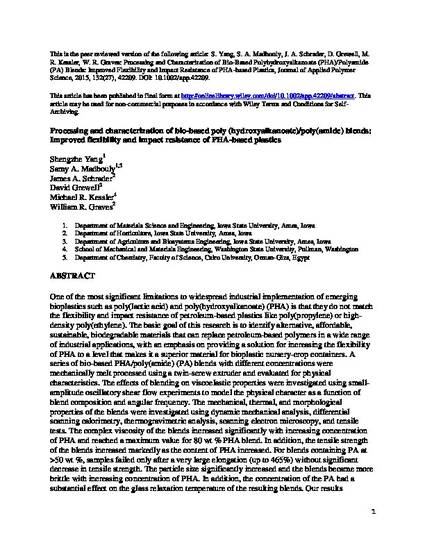
One of the most significant limitations to widespread industrial implementation of emerging bioplastics such as poly(lactic acid) and poly(hydroxyalkanoate) (PHA) is that they do not match the flexibility and impact resistance of petroleum-based plastics like poly(propylene) or high-density poly(ethylene). The basic goal of this research is to identify alternative, affordable, sustainable, biodegradable materials that can replace petroleum-based polymers in a wide range of industrial applications, with an emphasis on providing a solution for increasing the flexibility of PHA to a level that makes it a superior material for bioplastic nursery-crop containers. A series of bio-based PHA/poly(amide) (PA) blends with different concentrations were mechanically melt processed using a twin-screw extruder and evaluated for physical characteristics. The effects of blending on viscoelastic properties were investigated using small-amplitude oscillatory shear flow experiments to model the physical character as a function of blend composition and angular frequency. The mechanical, thermal, and morphological properties of the blends were investigated using dynamic mechanical analysis, differential scanning calorimetry, thermogravimetric analysis, scanning electron microscopy, and tensile tests. The complex viscosity of the blends increased significantly with increasing concentration of PHA and reached a maximum value for 80 wt % PHA blend. In addition, the tensile strength of the blends increased markedly as the content of PHA increased. For blends containing PA at >50 wt %, samples failed only after a very large elongation (up to 465%) without significant decrease in tensile strength. The particle size significantly increased and the blends became more brittle with increasing concentration of PHA. In addition, the concentration of the PA had a substantial effect on the glass relaxation temperature of the resulting blends. Our results demonstrate that the thermomechanical and rheological properties of PHA/PA blends can be tailored for specific applications, and that blends of PHA/PA can fulfill the mechanical properties required for flexible, impact-resistant bio-based nursery-crop containers.
Available at: http://works.bepress.com/david_grewell/23/

This is the peer reviewed version of the following article: Yang, Shengzhe, Samy A. Madbouly, James A. Schrader, David Grewell, Michael R. Kessler, and William R. Graves. "Processing and characterization of bio‐based poly (hydroxyalkanoate)/poly (amide) blends: Improved flexibility and impact resistance of PHA‐based plastics." Journal of Applied Polymer Science 132, no. 27 (2015)., which has been published in final form at 10.1002/app.42209. This article may be used for non-commercial purposes in accordance with Wiley Terms and Conditions for Self-Archiving. Posted with permission.